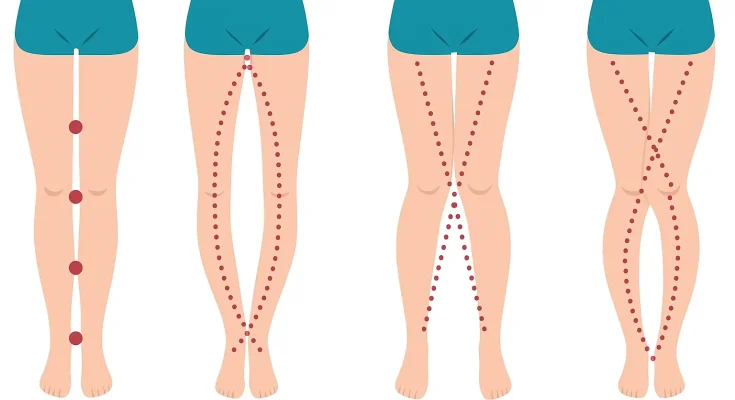When it comes to understanding the female body, few areas are as misunderstood—and as mystified—as the vagina. Often mislabeled, oversimplified, or completely ignored in everyday conversations, this essential part of the female anatomy plays a powerful role in reproduction, pleasure, hormonal balance, and even aging. And yes, while the alignment of your legs can say something about your body structure, it’s your vagina that tells the deepest stories about your health.
Let’s dive into the fascinating world of the vagina: what it is, what it isn’t, how it works, how it changes, and why it deserves more attention and respect.
🌸 Let’s Get the Terminology Right: Vulva vs. Vagina
One of the most common misconceptions is the interchangeable use of “vagina” to describe the entire genital area. In truth:
-
The vulva is the external part of the genitals. This includes the labia (inner and outer), clitoris, urethral opening, and the entrance to the vagina.
-
The vagina is the internal muscular canal that connects the vulva to the cervix.
Getting this distinction right is not just a matter of semantics—it’s about understanding your body, how it functions, and how to care for it.
🔍 What Is the Vagina?
The vagina is a flexible muscular canal, typically 7–12 cm long, that serves as a passage connecting the cervix (the entrance to the uterus) with the outside world. It plays key roles in:
-
Reproduction: The vagina receives sperm during intercourse and is the birth canal during delivery.
-
Menstruation: It’s the pathway through which menstrual blood exits the body.
-
Health Management: Hormonal creams, contraceptive rings, and medications can be inserted into the vagina for localized or systemic effect.
The vagina is designed to adapt and support a wide range of physiological functions—from holding a tampon to stretching enough to deliver a baby.
🧬 Anatomy: More Than Just a “Tube”
Though often referred to as a “tube”, the vagina is anything but simple:
-
The walls are collapsible: In a relaxed state, vaginal walls lie against each other like an accordion. This prevents things like tampons from falling out.
-
Rugae (folds): These allow expansion during intercourse and childbirth.
-
Mucosal lining: Like the tissue inside your mouth, the vagina’s lining helps keep it moist and protected.
-
Muscle & elasticity: Beneath the surface are layers of muscle and elastic fibers that support flexibility and strength.
🔄 How the Vagina Changes Over Time
Like every other part of your body, your vagina ages. From puberty through pregnancy and menopause, its structure and function adapt in response to hormonal changes.
-
During menstruating years: High estrogen levels keep the vaginal lining thick and elastic.
-
During pregnancy: Blood flow increases, tissues relax, and the vagina prepares to deliver a baby.
-
After childbirth: The vagina stretches significantly, but typically regains its form within 6–12 weeks postpartum.
-
After menopause: Estrogen drops, leading to thinner walls, dryness, and decreased natural lubrication. This can cause discomfort during sex and increase risk of irritation or infection.
Despite these changes, the vagina remains a strong, self-maintaining organ, capable of healing and adapting across a woman’s lifespan.
📅 The Menstrual Cycle & Vaginal Changes
Your vagina doesn’t stay the same day-to-day—it changes throughout your cycle:
-
Mid-cycle (around ovulation): Estrogen peaks, the cervix rises, becomes softer, and the vaginal walls thicken.
-
Fertile window: The cervix opens to allow sperm entry, and vaginal discharge becomes clear and stretchy to facilitate fertility.
-
Pre- and post-period: The cervix lowers, closes, and becomes firmer. Discharge may become cloudy or sticky.
These changes are completely normal and a good sign that your reproductive system is working in sync with your hormones.
💬 Myths vs. Facts
Let’s clear up some common misunderstandings:
-
Myth: The vagina is always open.
→ Fact: The vaginal walls are normally closed and only open when needed (e.g. during penetration or childbirth). -
Myth: All vaginas look and feel the same.
→ Fact: Just like faces, no two vaginas are identical. Size, shape, and elasticity vary widely. -
Myth: A “loose” vagina is a sign of too much sex.
→ Fact: Vaginal tightness is more related to pelvic floor muscle tone than sexual activity.
💡 Why Understanding the Vagina Matters
Knowing your anatomy isn’t just about science—it’s about empowerment. When you understand how your vagina works and how it changes, you’re better equipped to:
-
Advocate for your health
-
Notice signs of imbalance or illness
-
Understand your fertility
-
Enjoy intimacy without shame or misinformation
💪 Final Thoughts: The Vagina Is Powerful
From menstruation to motherhood, the vagina plays an irreplaceable role in a woman’s body. It is resilient, adaptive, and intricately linked to overall health and well-being. Learning about your anatomy isn’t just interesting—it’s essential for self-care.
Whether you’re in your teens or postmenopausal, it’s never too late to learn about and celebrate your body. So, let’s ditch the myths, embrace the facts, and talk about vaginas—loudly and proudly.
If you’d like a visual guide or infographics on vaginal health, or even tips for keeping your vulva and vagina healthy at every life stage, let me know—I’d love to help create it for you!
6 Habits Women Should Change to Avoid Gynecological Infections
Gynecological health is a vital part of overall well-being for women. However, many women unknowingly develop harmful habits that can increase their risk of vaginal infections and other reproductive health issues. If left unaddressed, these conditions can lead to discomfort, infertility, or more serious complications. Below are six common habits women should consider changing to protect their intimate health.
1. Infrequent Changing of Sanitary Pads During Menstruation
During menstruation, the vaginal area becomes more sensitive and prone to bacterial growth. Using sanitary pads correctly is essential for maintaining hygiene and preventing infections. One of the most overlooked practices is forgetting to change the pad frequently.
Even if menstrual flow is light, leaving a pad on for more than 3–4 hours can create a warm, moist environment that encourages the growth of bacteria and fungi. This can lead to unpleasant odors, irritation, or more serious infections like bacterial vaginosis or yeast infections. To maintain good hygiene, women should change their sanitary pads every 3–4 hours and ensure the area is gently cleaned and dried.
2. Wearing Tight or Non-Breathable Underwear
Wearing underwear that is too tight or made from synthetic, non-breathable fabrics can trap heat and moisture around the vaginal area. This creates an ideal environment for harmful bacteria and yeast to thrive, leading to issues such as irritation, itching, and recurrent infections.
For optimal vaginal health, opt for cotton underwear that allows airflow and wicks away moisture. It’s also advisable to avoid wearing underwear while sleeping to allow the area to stay dry and ventilated overnight.
3. Overusing Feminine Wash Products
Feminine hygiene washes are widely marketed to women as a way to feel clean and fresh. However, using them too frequently—especially multiple times a day—can do more harm than good. Many of these products contain chemicals that disrupt the natural pH balance of the vagina and kill off beneficial bacteria, leaving the area more vulnerable to infections.
Feminine washes should only be used occasionally, such as during menstruation, before or after intercourse, or when experiencing symptoms like excessive discharge or odor. Even then, opt for products that are mild, fragrance-free, and gynecologist-recommended.
4. Douching or Deep Vaginal Washing
The vagina is a self-cleaning organ with its own natural defense mechanisms. Douching—or inserting liquids or cleaning products inside the vagina—can disrupt the healthy balance of vaginal flora and eliminate good bacteria that protect against infections.
This practice not only increases the risk of bacterial vaginosis and yeast infections but can also push harmful bacteria deeper into the reproductive tract, potentially causing pelvic inflammatory disease. Instead, gently cleanse only the external vulva with warm water and a mild cleanser if needed. Avoid inserting anything into the vaginal canal.
5. Holding in Urine for Long Periods
Many women, especially those with busy schedules, delay urinating for extended periods. This habit can increase the risk of urinary tract infections (UTIs) by allowing bacteria to accumulate and multiply in the bladder.
The urinary system is closely linked to vaginal health, and a UTI can lead to discomfort, burning sensations, and even affect reproductive organs if left untreated. Make a conscious effort to empty your bladder regularly and drink plenty of water to flush out toxins.
6. Sitting for Long Hours Without Movement
Office workers and those with sedentary lifestyles often sit for long hours without breaks. Prolonged sitting restricts blood flow to the pelvic area and can cause congestion, which raises the risk of infections and other gynecological issues.
To counteract this, aim to stand up and stretch or walk around every 30–45 minutes. Light movement improves circulation, enhances oxygen flow, and helps reduce inflammation in the pelvic region.
Additional Tips to Maintain Vaginal and Reproductive Health
Maintaining good gynecological health goes beyond avoiding harmful habits. Here are some proactive steps you can take to ensure long-term wellness:
-
Keep the genital area clean and dry, especially during menstruation.
-
Wear breathable, cotton underwear, and avoid wearing damp clothing.
-
Follow a balanced diet rich in vitamins, antioxidants, and probiotics.
-
Stay physically active to promote better blood circulation and boost immunity.
-
Schedule regular gynecological checkups—at least once a year, or every six months if you have a history of gynecological issues.
Why Regular Gynecological Exams Matter
Routine gynecological visits are key to detecting and managing reproductive health issues early. Some of the benefits include:
-
Early detection of infections and cancers
-
Timely treatment of underlying issues
-
Counseling on sexual and reproductive health
-
Peace of mind and preventive care
A comprehensive gynecological checkup may include:
-
Pelvic examination
-
Breast check
-
Vaginal discharge (wet mount) microscopy
-
Abdominal and breast ultrasound
-
Transvaginal ultrasound
-
Pap smear and HPV (Cobas) test for cervical cancer screening
Final Thoughts
Women’s reproductive health is deeply connected to their daily habits and lifestyle. By being mindful of these six habits and adopting healthier routines, women can reduce their risk of gynecological infections and live with greater comfort and confidence. Prevention is always better than cure—start by listening to your body and treating it with the care it deserves.
📌 Stay informed. Stay empowered. Your health matters.



